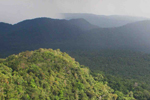Banana plantation threatens rainforest valley (video)
Cambodia’s Cardamom Mountains were recently spared a titanium mine, however now the region faces a new peril: bananas. The Australian firm Indochina Gateway Capital Limited has proposed a banana plantation in the Southern Cardamom Mountains. The plantation would likely destroy an elephant corridor for one of Cambodia’s last wild elephant populations. In addition, pesticides used in the plantation could pollute local waters, threatening nearly-extinct species, such as the royal turtle, and local people.
According to Wildlife Alliance: [we] recently proposed an alternate plantation location to Indochina Gateway as a win-win solution: Move the proposed location of the plantation to the nearby province of Kampot, where the same beneficial conditions exist (i.e. excellent water supply and good soil). Beyond that our proposed plantation area is actually closer to a harbor and labor sources, and it is located in truly degraded forest inside a low priority ecosystem.
For more information: Learn About the Threat to Key Tropical Forest Corridor Presented by Banana Plantation
For more on the conservation organization Wildlife Alliance:
Cambodia’s wildlife pioneer: saving species and places in Southeast Asia’s last forest

(05/11/2011) Suwanna Gauntlett has dedicated her life to protecting rainforests and wildlife in some of the world’s most hostile and rugged environments and has set the trend of a new generation of direct action conservationists. She has designed, implemented, and supported bold, front-line conservation programs to save endangered wildlife populations from the brink of extinction, including saving the Amur Tiger (also known as the Siberian Tiger) from extinction in the 1990s in the Russian Far East, when only about 80 individuals remained and reversing the drastic decline of Olive Ridley sea turtles along the coast of Orissa, India in the 1990s, when annual nestings had declined from 600,000 to a mere 8,130. When she first arrived in Cambodia in the late 1990s, its forests were silent. ‘You couldn’t hear any birds, you couldn’t hear any wildlife and you could hardly see any signs of wildlife because of the destruction,’ Gauntlett said. Wildlife was being sold everywhere, in restaurants, on the street, and even her local beauty parlor had a bear.
